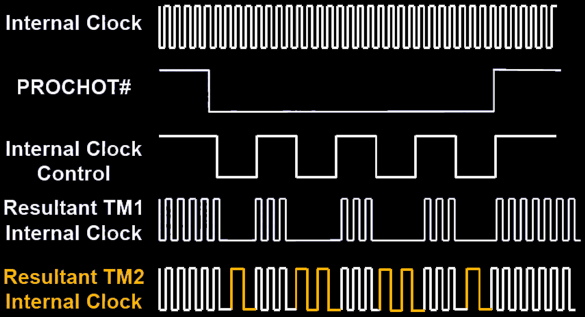A 4.1 GHz Dual Core at $130 - Can it be True?
Risk-free Overclocking, Including Heat Protection
The Pentium D supports version 2 of Intel's Thermal Monitor, a protective mechanism that enables the system to keep running and also prevents damage to the processor itself. Thermal Monitoring has been around since the Pentium 4 (Willamette) was introduced in 2000. If the CPU exceeds a specific temperature threshold, the clock controller for the processor automatically throttles back from time to time. This causes power consumption (and thus also heat output) to diminish quickly, though obviously performance will suffer noticeably.
The reworked Thermal Monitoring 2 is smarter, because the clock controller no longer skips clock cycles, but rather throttles back the processor clock rates. For this purpose, the controller likewise uses the PROCHOT signal, to allow the system to keep running smoothly, albeit at a reduced clock rate. Because the activation of PROCHOT as a protective mechanism through Thermal Monitoring 2 occurs right in the processor, neither BIOS updates nor settings changes are needed. The already described Enhanced Halt Mode C1E takes this one step further, and applies this when the idle process is running in the operating system.
Block diagrams of the workings of Thermal Monitoring 1 and 2.
Because Thermal Monitoring 2 provides a form of "overheating insurance", as it were; it's easier to overclock systems with this capability. Should the system overheat, it also reacts noticeably better than a system protected by Thermal Monitor 1. Thus, the second version of Thermal Monitor offers an additional bonus for overclockers to exploit.
Get Tom's Hardware's best news and in-depth reviews, straight to your inbox.
Current page: Risk-free Overclocking, Including Heat Protection
Prev Page Energy Saving Functions Lack C1E Next Page Ready For The 64 Bit FutureTom's Hardware is the leading destination for hardcore computer enthusiasts. We cover everything from processors to 3D printers, single-board computers, SSDs and high-end gaming rigs, empowering readers to make the most of the tech they love, keep up on the latest developments and buy the right gear. Our staff has more than 100 years of combined experience covering news, solving tech problems and reviewing components and systems.

